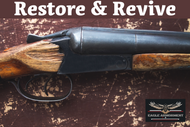Unlock the Artistry: Discover the World of Gunsmith and Firearm Restoration
Posted by Eagle Armorment on Mar 11th 2024
Unlock the Artistry: Discover the World of Gunsmith and Firearm Restoration
Step into the fascinating world of gunsmith and firearm restoration and unlock the artistry that goes into preserving and reviving these historical weapons. From meticulously stripping down a worn-out firearm to its bare bones, to delicately reassembling it, gunsmiths possess a unique skill set that marries craftsmanship with engineering precision. With a keen eye for detail and a deep understanding of the inner workings of firearms, these artisans breathe life back into antique guns, ensuring their authenticity and functionality.
In this article, we delve into the mesmerizing process of gunsmithing and firearm restoration, exploring the techniques and expertise required to transform rusty relics into works of art. Discover the secrets behind refinishing, rebluing, and wood restoration. Learn about the intricacies of fitting, adjusting, and repairing firearm components, and the importance of fine-tuning to achieve optimal performance.
Whether you're a history enthusiast, a gun collector, or simply intrigued by the skill and dedication it takes to restore firearms, this article will shed light on the captivating world of gunsmithing and firearm restoration. Join us as we unlock the artistry behind preserving these remarkable pieces of history.
The history and evolution of gunsmithing
Gunsmithing has a rich history that dates back centuries. The art of crafting and repairing firearms has been essential for civilizations throughout time. From the early days of handmade muskets to the advanced firearms of today, gunsmithing has evolved alongside technological advancements.
In ancient times, gunsmiths were highly revered craftsmen who were responsible for creating weapons used in warfare and hunting. As firearms became more prevalent, gunsmithing transitioned into a specialized trade. The Industrial Revolution brought significant changes to gunsmithing, with the introduction of mass production techniques and the standardization of firearm components.
The importance of firearm restoration
Firearm restoration plays a crucial role in preserving the historical significance of firearms. Antique guns, with their intricate designs and unique craftsmanship, are valuable pieces of history. However, the passage of time can cause these firearms to deteriorate, losing their original beauty and functionality.
Restoring antique firearms not only brings them back to their former glory but also ensures their continued existence for future generations to appreciate. By carefully cleaning, repairing, and refitting parts, gunsmiths breathe new life into these weapons while maintaining their authenticity.
Tools and equipment for gunsmithing and firearm restoration
Gunsmiths rely on a wide array of specialized tools and equipment to perform their craft. These tools range from basic hand tools to precision measuring instruments. A few essential tools include:
1. Screwdrivers: Gunsmiths use specialized screwdrivers with hollow-ground tips to prevent damage to firearm screws.
2. Files: Files of various shapes and sizes are used for shaping and fitting firearm parts.
3. Hammers and punches: Gunsmiths use hammers and punches to remove pins, drift sights, and perform other tasks requiring controlled force.
4. Cleaning supplies: A clean firearm is crucial for proper restoration. Gunsmiths use solvents, brushes, and patches to remove dirt, rust, and debris.
5. Measuring instruments: Calipers, micrometers, and gauges are essential for precise measurements during fitting and assembly.
Gunsmithing techniques and processes
Gunsmithing involves a wide range of techniques and processes to restore firearms to their original condition. Here are some key techniques commonly employed by gunsmiths:
1. Stripping and cleaning: Gunsmiths start by stripping down the firearm to its individual components, carefully cleaning each part to remove dirt, rust, and old lubricants. This process ensures a clean canvas for further restoration.
2. Refinishing and rebluing: Gunsmiths apply various techniques to refinish the metal components of a firearm, such as sandblasting, polishing, and bluing. Bluing involves treating the metal with chemicals to create a protective oxide layer, giving the firearm a deep, lustrous finish.
3. Wood restoration: Many antique firearms feature wooden stocks that require special attention. Gunsmiths repair cracks, sand down imperfections, and refinish the wood to restore its original beauty.
4. Fitting and adjusting: Gunsmiths carefully fit and adjust firearm components to ensure proper functionality and accuracy. This involves precise measurements, filing, and shaping to achieve a perfect fit.
5. Fine-tuning and testing: Once the firearm is reassembled, gunsmiths fine-tune the various mechanisms and test the firearm's performance to ensure it operates safely and reliably.
Common challenges in gunsmithing and firearm restoration
Gunsmithing and firearm restoration can be complex and challenging endeavors. Some common challenges faced by gunsmiths include:
1. Limited availability of original parts: Finding authentic, original parts for antique firearms can be difficult. Gunsmiths often have to rely on reproduction parts or fabricate missing components.
2. Dealing with rust and corrosion: Rust and corrosion are common issues in antique firearms. Removing rust without damaging the metal requires careful techniques and specialized tools.
3. Understanding different firearm designs: Gunsmiths must have a deep understanding of various firearm designs and their specific mechanisms to effectively repair and restore them.
4. Maintaining historical accuracy: Gunsmiths need to balance the restoration process with maintaining the historical accuracy of the firearm. This involves researching the firearm's history and ensuring the restoration aligns with its original features.
5. Safety considerations: Gunsmiths must always prioritize safety when working with firearms. This includes following proper handling and storage protocols and performing thorough function checks after restoration.
Tips for beginners in gunsmithing and firearm restoration
If you're interested in getting started with gunsmithing or firearm restoration, here are some helpful tips to keep in mind:
1. Start with basic projects: Begin by working on simpler firearms or components to develop your skills and understanding of the craft.
2. Invest in quality tools: High-quality tools are essential for precision work. Invest in reliable tools that will last and provide accurate results.
3. Learn from experienced gunsmiths: Seek mentorship or take classes from experienced gunsmiths to learn proper techniques and gain valuable insights.
4. Study firearm designs and mechanics: Develop a strong understanding of different firearm designs and their inner workings to effectively troubleshoot and repair them.
5. Practice patience and attention to detail: Gunsmithing requires patience and meticulous attention to detail. Take your time and ensure every step is done correctly.
Gunsmithing and firearm restoration courses and certifications
For those who want to pursue gunsmithing as a career or deepen their knowledge and skills, there are various courses and certifications available. These programs provide comprehensive training in gunsmithing techniques, firearm restoration, and the business aspects of the industry.
Some reputable institutions offering gunsmithing courses include:
1. Sonoran Desert Institute
2. Colorado School of Trades
3. Trinidad State Junior College
4. Pennsylvania Gunsmith School
5. Montgomery Community College
Obtaining a recognized certification can enhance your credibility and open doors to employment opportunities within the gunsmithing industry.
Hiring a professional gunsmith or firearm restorer
If you have a valuable antique firearm that requires restoration, it is advisable to seek the services of a professional gunsmith or firearm restorer. Hiring an experienced expert ensures that the restoration process is carried out with the utmost care, preserving the firearm's value and historical accuracy.
When selecting a gunsmith or firearm restorer, consider their experience, reputation, and expertise in working with the specific type of firearm you own. It's also important to discuss the restoration goals and expectations upfront to ensure both parties are aligned.
Embracing the art of gunsmithing and firearm restoration
Gunsmithing and firearm restoration are not only about preserving historical artifacts but also about honoring the artistry and craftsmanship that went into creating these remarkable pieces. The skill and dedication required to restore firearms to their former glory is truly awe-inspiring.
Whether you choose to embark on the journey of gunsmithing yourself or entrust your treasured firearms to the hands of professionals, the world of gunsmithing and firearm restoration is a captivating one. Embrace the artistry and immerse yourself in the rich history and fascinating techniques that bring these weapons back to life.



